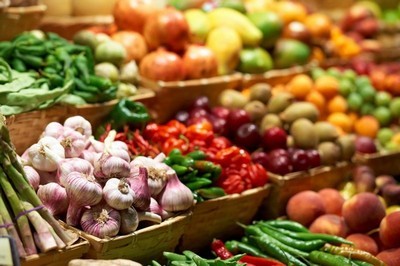How to contain the rise in prices

 Rapid tests PIONER 5 in 1 for the determination of sulfonamides, tylosin, tilmicosin, lincomycin, erythromycin, fluoroquinolones
Rapid tests PIONER 5 in 1 for the determination of sulfonamides, tylosin, tilmicosin, lincomycin, erythromycin, fluoroquinolones PIONEER MEIZHENG BIO-TECH (5 in 1) JC0726 / Rapid tests for determining the residual amount of Bacitracin, ansamycins, clindamycin, spiramycin, florfenicol in milk, whey
PIONEER MEIZHENG BIO-TECH (5 in 1) JC0726 / Rapid tests for determining the residual amount of Bacitracin, ansamycins, clindamycin, spiramycin, florfenicol in milk, whey
The government is preparing to build a system to counter the rise in world prices for socially important goods. it is based on economic models created by industry departments that describe the dependence of the cost of certain products and EXPORT goods on the Russian market on global inflation. In the event of an increase in world prices for these goods, the government through customs duties and tariffs will compensate for their impact on prices in RUSSIA.
The organization of work to create, maintain and promptly update models for monitoring and forecasting price dynamics in domestic markets is an example of the best international experience in terms of the work of financial and economic departments. The relevance of this area of work is increasing in the context of a steady increase in inflation around the world, caused by the realization of pent-up demand, the disruption of global supply chains and excess free liquidity in the system. For example, inflation in the US in recent months has been holding its highs since mid-2008 (5.4% in annual terms), in the EU inflation has increased to 3.4% - such rates of price growth have not been observed in Europe for at least the past two decades.
Price pressure is observed across a wide range of commodities, industrial and agricultural products. According to Rosstat, in January-August 2021, the price of steel profiles purchased by construction organizations in Russia increased by more than 28%. The price of reinforcement for reinforced concrete structures was 41% higher. The most negative situation was observed in the Volga and Siberian Federal Districts, where the growth of more than two times was recorded for certain commodity items of metal products. The rise in prices on the Russian market was associated primarily with the dynamics of world steel prices, as well as the influence of certain local factors.
The dynamics of world prices can be tracked by quotations on the Shanghai Commodity Exchange, where hot-rolled steel prices in October 2021 were about $855 per ton, which is 52% higher than a year ago. Peak values were observed in mid-May ($1027) and in the first days of August ($947), which are multi-year highs.
By October, prices corrected somewhat, but high prices on the world steel market persist. This dynamic is driven by pent-up demand for steel as the global economy recovers from the covid-19 pandemic, while the growth rate of steel production in the world lags behind the growth rate of demand. Severstal expects world steel prices to remain above average historical levels for another 2-3 years. In response, the government took new measures to support the construction industry and allowed to increase the price of a state contract for construction work by 30% as compensation for additional costs associated with a significant increase in the cost of building materials. In addition, in order to partially limit the growth of domestic prices for metal products, at the end of June, the Cabinet of Ministers announced the introduction of export duties on the export of more than 340 types of metal products for the period from August 1 to December 31, 2021. The new fee extended to rolled products, fittings, blanks, wire, and ingots. It consists of a base rate of 15% and a specific,
Read together with it:
- Боливия экспортирует говядину на сумму 797 миллионов долларов и вводит новые цифровые сертификаты для внешней торговлиЭкспорт говядины из Боливии в период с 2021 по 2025 год достиг 797 миллионов долларов. Китай является основным рынком сбыта этого мяса, на который приходится 74% продаж, сообщила Карина Серрудо, генеральный директор Национального таможенного управления. Параллельно с этим ведомство включило сертификат безопасности экспортных пищевых продуктов для говядины в систему «Единое окно для внешней торговл...
- Поголовье свиней в Бразилии продолжает растиТакже наблюдался рост убоя свиней на 1,2%, достигнув рекордного уровня в 2024 году, хотя рост сектора замедлился. Экспорт свинины также достиг исторического максимума. По географическому распределению Толедо (штат Парана) сохранил лидерство по производству свинины среди 5487 муниципалитетов, где ведётся свиноводство, на долю которого приходится 2,2% от общего поголовья (95......
- Bloomberg узнал о плане G7 значительно ужесточить санкции против РоссииНовый пакет санкций будет включать меры, в частности, против энергетики, финансов и военной промышленности, а также крупнейших нефтяных компаний России. Разработку пакета G7 планирует завершить в октябре, выяснил BLOOMBERG Страны «Большой семерки» (G7) приближаются к соглашению о значительном ужесточении санкций в отношении России, сообщает агентство Bloomberg со ссылкой на проект заявления. «Мы с...
- Фон дер Ляйен заявила о смене подхода к санкциям против РоссииНовый подход подразумевает не предложение поэтапных санкций, а «гораздо более жесткие меры» в отношении энергетики, финансовых услуг и торговли, все это уже входит в 19-й пакет, заявила глава ЕК Урсула фон дер Ляйен Евросоюз при подготовке 19-го пакета санкций против России меняет подход, переходя «от поэтапного усиления давления к жестким мерам». Об этом заявила глава Европейской комиссии Урсула ...
- "Cardboard Superpower." What is Poland prepared to take into 2026?Photo: Unsplash The Polish government has submitted its draft 2026 budget to the Sejm. In short, the hole in the Polish budget is growing even wider, and the national debt is on the verge of skyrocketing. Meanwhile, military spending is breaking records, cementing Poland's status as NATO's leader in defense spending as a percentage of GDP. However, the value of such leadership is questionable. Or ...



























































